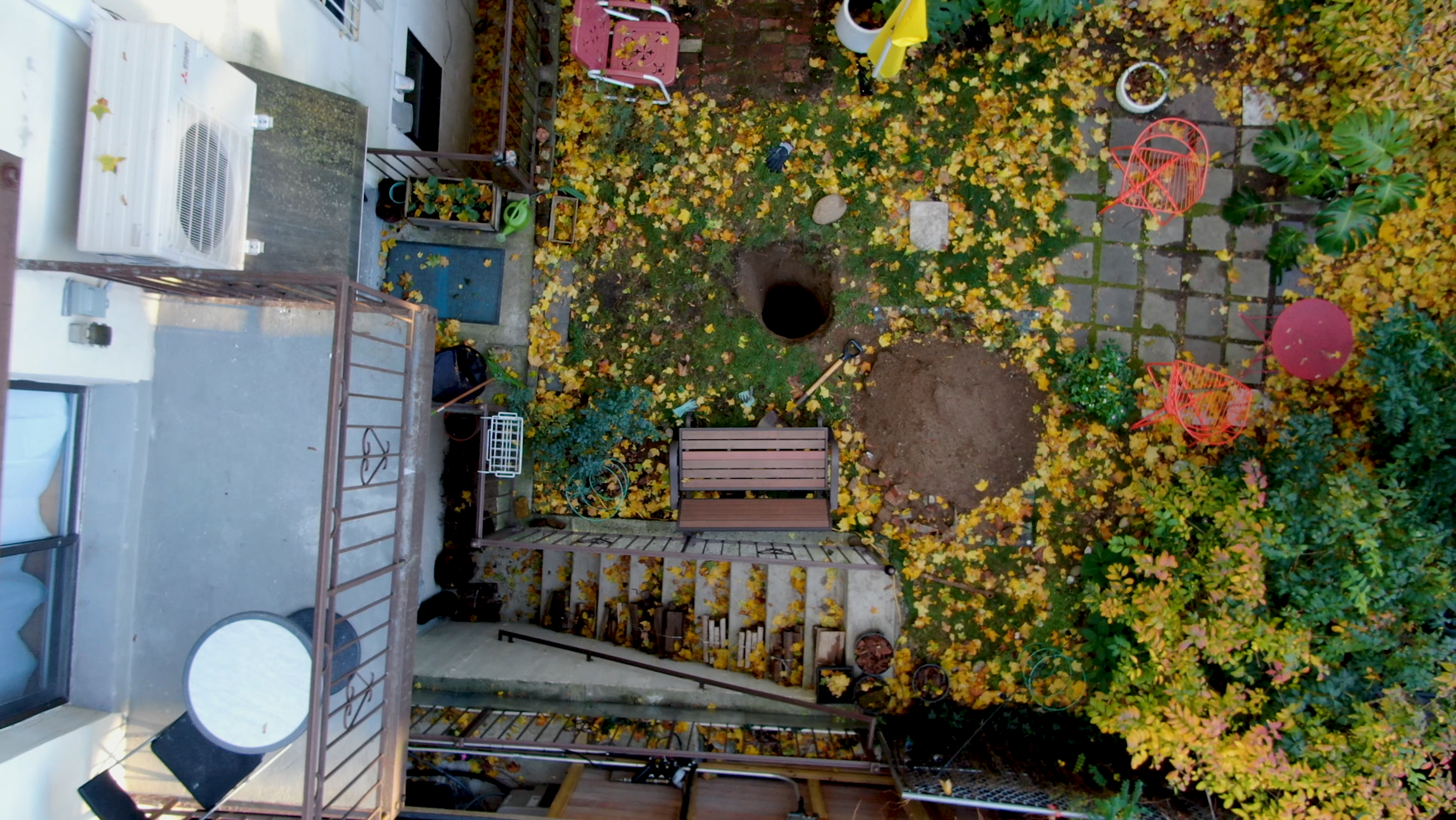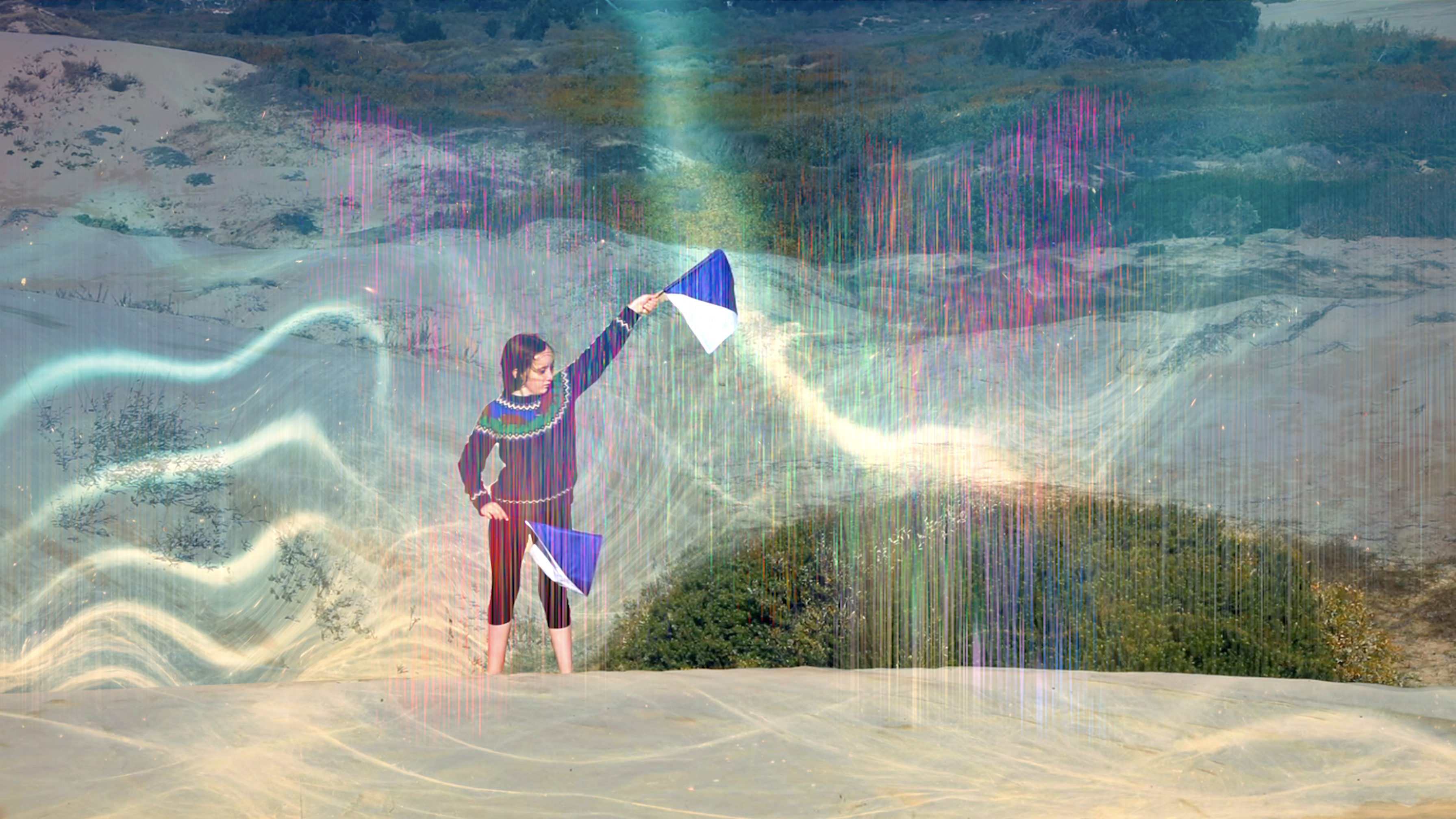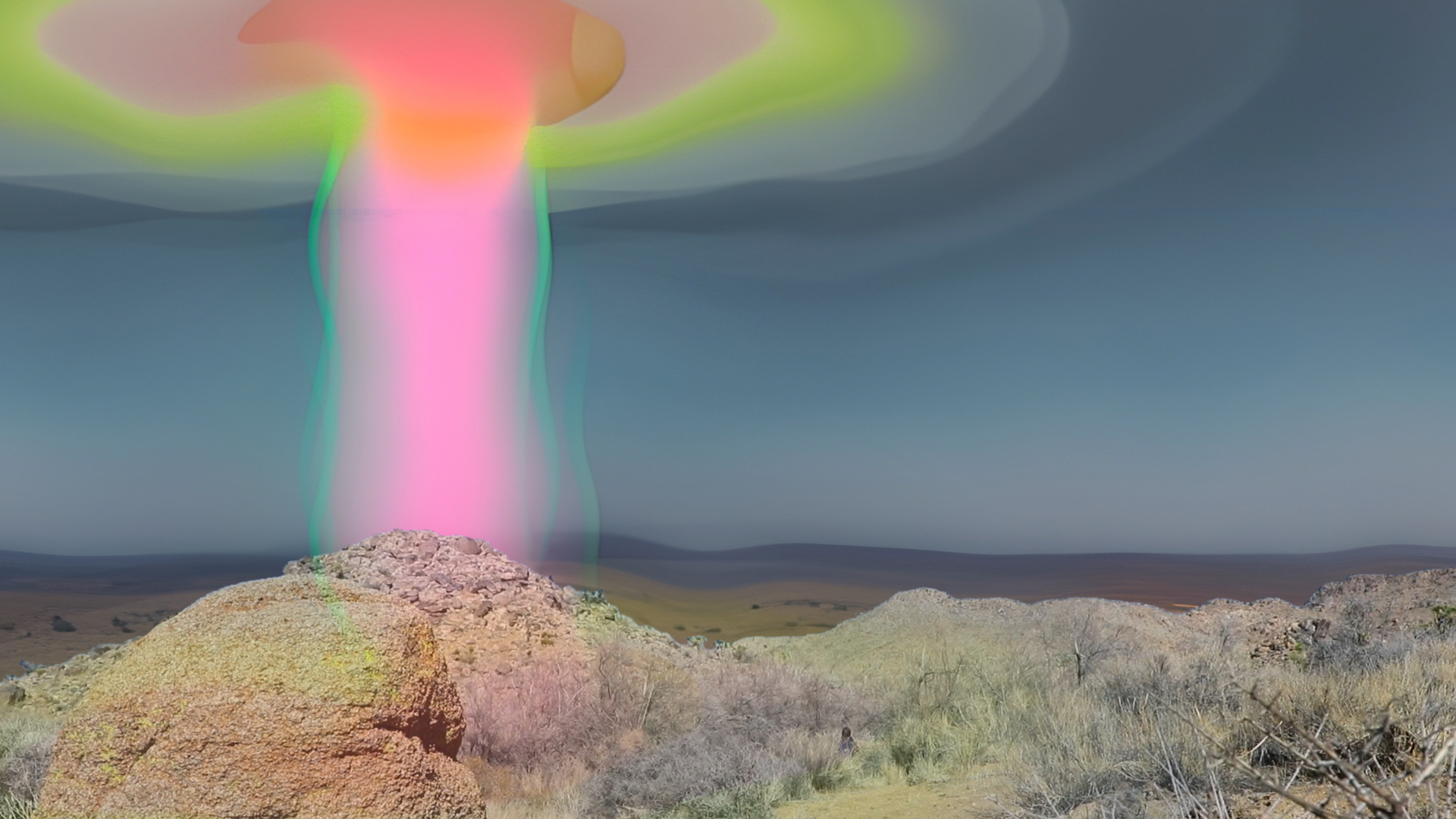
Jillian McDonald, Tunnel and Radio Skies, 10’58”, 2024
Interview with Jillian McDonald
by Nung-Hsin Hu
Jillian McDonald is a Canadian artist and professor living in Brooklyn and Troy, NY. She recently made videos in natural landscapes filled with unnatural haunted things, and drawings of holes in the ground, columns of smoke, and tangles of snakes. Jillian has a conversation with Nung-Hsin Hu where she shares her complex inspirations and processes of creating Tunnel and Radio Skies, a long term video project that she was finalizing during her time with Temp Files.
NH: Your current project “Tunnel and Radio Skies” starts with you digging a hole in your backyard, and the action continues in various locations. You also have a “Deep Holes” drawing series. Could you talk about what “holes” or the action of “digging a hole” represent in your projects?
JM: I have been making holes since 2019, not long after I moved to a home with a backyard for the first time as an adult and couldn’t resist digging into the ground. I first made a collaborative video called The Dig with Canadian artist Linda Duvall, in which we each dig a very deep hole - Linda on her Saskatchewan prairie acreage and I in my Brooklyn backyard. The two digs are presented side by side as a two-channel video, with over two hours of digging in real-time (Linda) and edited time (Jillian) because my hole took several days to dig. Eventually, after we disappear below ground, something mysterious happens - it could be real or it could be impossible or even supernatural but we leave it to the viewer to decide.
The Dig, Jillian McDonald and Linda Duvall, 2-channel video, 2:30:00, 2022
Since 2020, during the height of the Covid-19 pandemic, I’ve been drawing holes on paper. The first ones I drew were animal burrows and entrances to tunnels, as I imagined escape routes or portals out of my Brooklyn apartment. Later drawings were ruptures in the earth, signals of climate change and collapse. Some of these are sinkholes where the surface area is subterranean; moulins or tunnels in glaciers created by meltwater; gas emission craters, where melting permafrost releases enormous volumes of trapped gas in an explosive crater-forming event; or the infamous Gates of Hell in Turkmenistan — a fiery crater left burning since a 1971 Soviet drilling accident. I named all the hole drawings with phrases that include the word “deep” like Deep State, Deep Breath, and Deep Meaning.
![]()
Deep Fear, Jillian McDonald, Colored pencil on paper, 30 x 20 inches, 2020
I also drew roots underground, by leaving the roots themselves as negative space in the coloured soil around them, which are holes as well. They are titled with phrases including the word “dark”, such as Dark Web and Dark Days.
Animals on the Verge is a video that juxtaposes Google’s ready-made 3D animals, considered a “perfect quarantine activity,” with my drawings of holes on paper, via Augmented Reality and recorded on a mobile device. Animals like a Pomeranian dog and an octopus bark at the edge of, or tread water in giant holes in the earth and ice. The animals appear curious, distressed, or oblivious, in limbo but unharmed.
And Tunnel and Radio Skies starts with another hole, in the same Brooklyn backyard. Going underground was dark, scary and exciting, reminding me of the common childhood imagination that considers crossing the world via a hole. Excavation is interesting too - what lies beneath our feet is only sometimes what we expect. I thought I might find bones or treasure but it’s only garbage underground in my yard.
The holes all together are escapes, portals, burrows, traps, and tunnels. They are metaphorical and literal. The fear of the unknown, the comfort of the underground. If you ever watched a worm or a burrowing animal dig, it’s so fascinating, using their body to push or eat through the earth. Many people, too, have stories about holes: digging through a basement wall to cross a street, keeping warm underground in northern places, burying things to hide or protect them.
NH: Also, radio waves is such an unusual subject, and I am wondering what is your inspiration for working with radio waves?
JM: My connection with radio waves has two sources. One goes back to the collaborative work with Linda Duvall that I mentioned above, which we showed in 2022 in Canada at the Art Gallery of Regina as part of our larger exhibition and community project called “Messages from the Rocks, Stories of the Invisible”. We consulted with a variety of people from different fields - an archaeologist, a geologist, an art historian, an audio ecologist, a biologist, an indigenous knowledge keeper, and a bat researcher. Collaborating with some of these folks, we offered nature walks during which they shared their knowledge about the invisible or unexplainable things in the land (like electromagnetic waves). We picked up radio signals from the metal frame behind a baseball diamond, heard powerful vibrations under a bridge, and built bat detection devices to hear bats which are normally beyond the range of human hearing. The possibility of visualizing electromagnetic signals was sparked by these activities.
Tunnel and Radio Skies, Jillian McDonald, Video, 24:00 minutes, 2024
Simultaneously, I was studying for an amateur radio license because I have a future project in mind about speaking to the trees and the forest through radio. The prep manual for ham radio covers basic electronics, particularly as they pertain to sound. It’s super technical and hard for me to read. In the margins of the technical manual I took notes that seem to seek the more poetic aspects of sound and radio waves. I wrote that signals bounce off the ionosphere, are affected by electromagnetic activity from the Auroras, and are absorbed by plants. Those passages are highlighted in my manual even though they are not germane to the radio license test.
NH: Following up on the previous question, in your past work, you have frequently used digital manipulation in your projects, and “Tunnel and Radio Skies” is your first time incorporating artificial intelligence(AI). Could you talk about the reason for choosing to work with AI, the process involved, and how that changes your practice?
JM: In 2022 I took a workshop at an artist residency. The workshop was about creating images using artificial intelligence, specifically text to image generating software. The workshop was run by a young man who was demonstrating how he creates images of beautiful women, and cleans up and perfects them. I was zoning out while he was talking because I couldn't imagine why we need more images of beautiful women, and I was typing in those passages from the radio manual. The images turned out crazy and abstract and technical, though inaccurate. For months I was generating different images from only a handful of phrases, creating a massive archive of images. I used these images as a starting point, animating in After Effects and other software, and compositing them into the skies and parts of the landscape, as though radio signals are moving through the landscape. The process completely changed the direction of my project.
NH: There is no dialogue in the video, but there is a strong sense of the apocalypse, science fiction as well as the feeling of uncertainty back in the Pandemic era. Could you discuss what the main concept you intend the viewer to receive is?
JM: I used to make works that were about horror film themes and included horror archetypes like zombies, vampires, and masked figures to signal collapse and surrender. I’ve moved away from those ideas into a kind of speculative fiction and eco-horror. Speculative fiction offers a world that is at least partially unreal and eco-horror is a subgenre of horror in which the natural world itself invokes fear, there’s no other terror lurking in nature. But I don’t think Tunnel and Radio Skies has to be apocalyptic necessarily, I see the nature there as sublime. James Bridle writes in Ways of Being that volatile weather and natural disasters are signs of things looking up, at least for the Earth. They might be ways of wiping out humans now that human exceptionalism is suspect. Nicole Seymour writes in Bad Environmentalism that earnestness and sympathy and other modes of presenting environmentalism inspire defeatism - after all, what can we do when faced with a planet that is on fire and melting? She champions ecologically-minded art that is irreverent or campy like Isabella Rosellini’s Green Porno, or the Lesbian Rangers’ national park interventions, and suggests these opposite modes can inspire action. I want to add, what about horror and sci-fi, which traffic in creating worlds that are trashy or campy? They are speculative, wildly imaginative, and terrifying but sometimes gorgeous.
”Storytelling — whether through fiction, documentary, data science or sociology, and however optimistic — might seem a limp response to the climate crisis. Narrative won’t stop coral bleaching or the leaking of methane from Arctic soil into the atmosphere. But it’s a tool that’s available, cheap and endlessly renewable. And as a society, we will not act on climate change until we’re convinced that our action is useful and urgent.” -From Climate Doom Is Out, “Apocalyptic Optimism” Is In by Alexis Soloski for The New York Times.
NH: I am curious about the character played by Violet (Jillian’s daughter) with the flag; what’s the message she was sending out? What is the relationship with your character?
JM: My daughter is playing a signal-sending figure, repeating the word ”where” with semaphore flags - it could be a question, or a call or provocation. She's signaling and my character is trying to find her throughout the journey. At the very end, we're in the same landscape, but it's not so important to me whether that’s clear or not, it’s a subtext. And we don't find each other exactly, rather we disappear into the landscape, into the signal in the last clip, possibly absorbed into the radio waves. But it's meant to be ambiguous. My character could be part of the radio signal at that point, or dead, or stuck between worlds.
NH: Your “Tunnel and Radio Skies” reminds me of Cosmic Generator (Tunnel Variant) by Mika Rottenberg, which is a tunnel system that establishes a trading connection between various places and actors, including the US, Mexico, and China. Of course, your tunnel is invisible, but if you have a chance to make it visible, what will the tunnel look like? Did you have any references when you worked on this project?
JM: That’s an interesting comparison. Rottenberg’s work is much more glittery and character driven than mine, and I love all of her video work. My tunnel would probably look like the earth - dark and crumbly, full of construction garbage in Brooklyn, sand in Arizona, and rocks in Newfoundland, but also morphing and glitching, like the transitional images between locations in my video. I shot footage of a tunnel using a borescope but I didn’t use it after all, maybe it will appear in another work someday.
Obvious references include the radio manual, and the books I mentioned above. The landscapes themselves were really inspiring, I thought about not even including the figure, and there is some of that in the video, but I decided the figure is necessary to show the journey. I recently read Laurie Palmer’s The Lichen Museum which presents lichens as organisms that are older than humans and live everywhere. In my next work the lichens might be the protagonists, watching the action unfold.
NH: I understand “Tunnel and Radio Skies” is a long-term project that you have been working on for years (2021-2024). I am very curious about your processes to bring the work together. When you did the editing with numerous amounts of footage/material, how did you connect them? Do you follow the visual connection or have a narrative in your mind?
JM: I fall somewhere in between having a very clear plan that I execute, and working in an intuitive and experiential way. I usually have a general idea of what I want but then I shoot tons of footage and it takes a long time to shape it after the fact. With a big project like this I’m mostly calmly shooting, while wrestling with the narrative logic in my head. When it comes together finally I am overjoyed, like I solved a mystery or puzzle.
The one time I made a storyboard was for a project called Valley of the Deer, in Scotland during a nine-month-long residency, when I had the luxury of extended time in one place for location scouting and planning. There was no dialogue in that work either, but I planned it all out clearly, before shooting.
With Tunnel and Radio Skies I had an intended narrative arc, then it totally changed, and I was frustrated with the project in the early period of working. The work received major funding from the Canada Council for the Arts, so I had resources to make it. The timing was the strange thing that made me question my process, spanning the period of the pandemic when I was locked down in an epicenter and at high risk due to asthma. Once I discovered the AI magic, it unlocked part of the puzzle and reignited my desire to make this work. I love shooting but I have a love-hate relationship with editing, at first I avoid it at all costs for fear of not finding the story, but once I start in and I can see the arc or shape of the project, animating short sequences and putting them back into the timeline, back and forth over and over again, it becomes pleasurable, or at least satisfying. I do most things the hard way and very DIY, and usually need a rest when a major video is done.
NH: You joined Temp. Files during your post-production period. Could you share how this experience affected your project?
JM: Temp Files was an excellent experience for me, thank you for inviting me, Nung-Hsin. I’m not accustomed to having feedback during post-production, especially after working on this project for so long. Suggestions and comments from peers helped me distance myself from all the details and realize what was working and what wasn't, in the logic of the narrative. This group’s diverse set of references from eco-feminism and futurism to landscape and vintage sci fi and montage films, brought many sparks of inspiration. I ended up shooting a new scene of me emerging from the first tunnel to make a visual link between those two places, which the group identified as missing.
![]()
Tunnel and Radio Skies, Jillian McDonald, Video, 24:00 minutes, 2024









